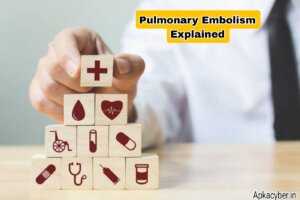
Understanding Pulmonary Embolism: Causes, Symptoms, Diagnosis, and Treatment
Pulmonary embolism (PE) is a serious medical condition that can have life-threatening consequences if not promptly addressed. It occurs when a blood clot blocks one or more arteries in the lungs, often originating from the deep veins of the legs, a condition known as deep vein thrombosis (DVT). In this article, we will explore the causes, symptoms, diagnosis, and treatment of pulmonary embolism, providing essential information to understand this critical condition and its management.
What is Pulmonary Embolism?
Pulmonary embolism is a blockage in one of the pulmonary arteries in the lungs, typically caused by blood clots that travel from the legs or other parts of the body (deep vein thrombosis) and become lodged in the lungs. These clots can impair blood flow to the lungs, leading to reduced oxygen levels in the bloodstream and potentially causing damage to lung tissue.
Causes and Risk Factors
The primary cause of pulmonary embolism is the formation of blood clots, often due to a condition known as deep vein thrombosis (DVT). Several factors can increase the risk of developing DVT and, consequently, pulmonary embolism:
- Prolonged Immobility: Long periods of inactivity, such as during long flights or bed rest after surgery, can contribute to blood clot formation.
- Surgery: Particularly surgeries involving the hips, knees, or abdomen, can increase the risk of blood clots.
- Cancer: Certain types of cancer and cancer treatments can increase the risk of clot formation.
- Hormonal Changes: Hormone replacement therapy or oral contraceptives can elevate clotting risk.
- Genetic Factors: Inherited conditions like Factor V Leiden or Prothrombin gene mutation can predispose individuals to clot formation.
- Obesity: Excess weight can increase the risk of developing blood clots.
Symptoms of Pulmonary Embolism
The symptoms of pulmonary embolism can vary in severity and may include:
- Shortness of Breath: Sudden difficulty in breathing is a common symptom of PE.
- Chest Pain: Sharp or stabbing pain in the chest, which may worsen with deep breaths or coughing.
- Coughing: Often accompanied by blood-tinged sputum.
- Rapid Heart Rate: A racing or irregular heartbeat may be present.
- Lightheadedness or Fainting: Severe cases can lead to dizziness or loss of consciousness.
- Swelling: Swelling in the legs, particularly in the calf, may indicate deep vein thrombosis, which can lead to pulmonary embolism.
Diagnosis of Pulmonary Embolism
Diagnosing pulmonary embolism involves several steps, including:
- Medical History and Physical Examination: A healthcare provider will review symptoms and risk factors.
- Imaging Tests: A CT pulmonary angiogram (CTPA) is commonly used to visualize blood clots in the lungs. A ventilation-perfusion (V/Q) scan may also be used if CTPA is not suitable.
- Blood Tests: D-dimer tests measure the level of a substance released when a blood clot breaks up. Elevated levels may suggest clotting but are not definitive.
- Ultrasound: To detect deep vein thrombosis in the legs, which can help confirm the source of the clot.
Treatment Options for Pulmonary Embolism
Treatment for pulmonary embolism depends on the severity of the condition and the overall health of the patient:
- Anticoagulants: Blood thinners such as heparin or warfarin help prevent further clotting and reduce the size of existing clots.
- Thrombolytics: In severe cases, clot-busting medications may be administered to dissolve the clot more rapidly.
- Surgical Intervention: In critical situations, surgical procedures such as embolectomy may be performed to remove the clot.
- Inferior Vena Cava (IVC) Filter: For patients who cannot take anticoagulants, an IVC filter can be placed to catch clots before they reach the lungs.
Prevention and Management
Preventing pulmonary embolism involves addressing risk factors and taking proactive measures:
- Regular Exercise: Promotes healthy circulation and reduces the risk of clot formation.
- Medication Adherence: Following prescribed anticoagulant therapy if at risk.
- Compression Stockings: Help prevent blood clots in individuals at high risk.
- Lifestyle Changes: Maintaining a healthy weight and avoiding prolonged periods of immobility.
Conclusion
Pulmonary embolism is a serious condition that requires prompt medical attention to prevent complications and ensure effective management. By understanding the causes, recognizing the symptoms, and seeking timely diagnosis and treatment, individuals can significantly improve their outcomes. Awareness and proactive measures are crucial in managing and preventing this potentially life-threatening condition.